Watch-paper of Sam Toulmin, The Strand, London

Watch-paper of Rob Fleetwood, London

Thos. Field Watch Maker
Aylesbury
Wedding & Mourning
Rings made Likewise
most Money given for
Second Hand Plate
Watches &c
[note: the above 3 watchpapers have equation tables]
Aylesbury
Wedding & Mourning
Rings made Likewise
most Money given for
Second Hand Plate
Watches &c
[note: the above 3 watchpapers have equation tables]

George Prior Clock and Watchmaker
in Prescot St Goodman's Field, London
in Prescot St Goodman's Field, London

Un-cut watch-paper/trade-card of
Richard Whiteaves, Clock & Watch Maker
Fleet Street, London [1801]
Richard Whiteaves, Clock & Watch Maker
Fleet Street, London [1801]
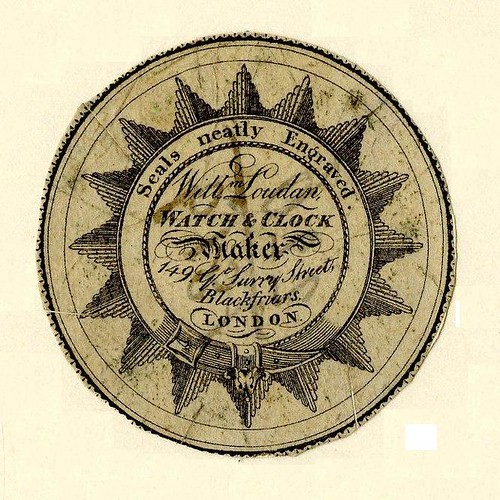
Watch-paper of William Loudan,
Blackfriars, London (maybe 1825-1840)
Blackfriars, London (maybe 1825-1840)
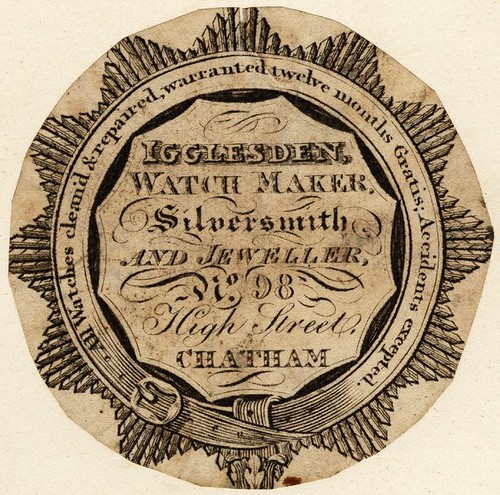
Igglesden Watch Maker,
Silversmith & Jeweller,
High Street Chatham
[garter-belt border bearing inscription]
Silversmith & Jeweller,
High Street Chatham
[garter-belt border bearing inscription]

Green cut edged with yellow centre watch-paper,
stylised sunflower, with smiley face, in outer case. (~1732-1770)
stylised sunflower, with smiley face, in outer case. (~1732-1770)

Richardson Watch & Clock Maker, Brampton
To Make a Watch go Slower
turn the Regulator the same way you Wind up,
Faster the contrary
To Make a Watch go Slower
turn the Regulator the same way you Wind up,
Faster the contrary

Thos. Brown
Clock & Watch Maker
Birmingham (1796)
Clock & Watch Maker
Birmingham (1796)
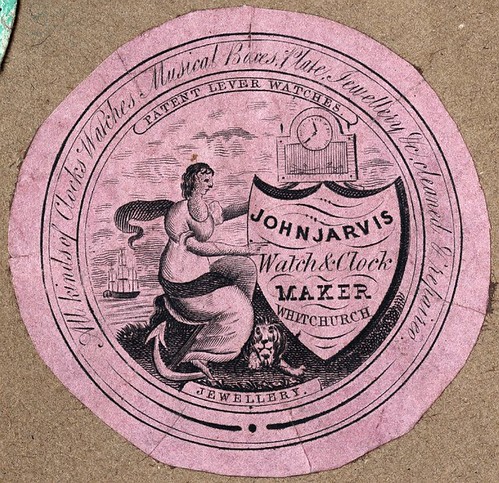
John Jarvis
Watch & Clock Maker
Whitchurch
All kinds of Clocks Watches
Musical Boxes Plate Jewellery &c
cleaned & repaired
Watch & Clock Maker
Whitchurch
All kinds of Clocks Watches
Musical Boxes Plate Jewellery &c
cleaned & repaired
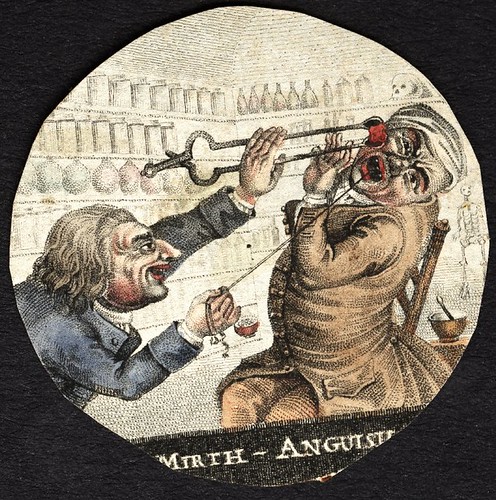
Mirth - Anguish
(coloured print of dentist drawing tooth from patient)
[presumably this is a 'ready-made', cut from a book or print]
(coloured print of dentist drawing tooth from patient)
[presumably this is a 'ready-made', cut from a book or print]

What!?

Edwd Glase
Clock & Watch Maker Bridgnorth
Repeating Watches Carefully Repaired
Clock & Watch Maker Bridgnorth
Repeating Watches Carefully Repaired

W. Owen
Clock & Watch Maker
Jeweller & Silversmith
Oswestry
Clock & Watch Maker
Jeweller & Silversmith
Oswestry

Bowen & Downes
Watch & Clock Makers
London
Watch & Clock Makers
London

John Wieland
Clock & Watch Maker
Penton Row, Walworth
Tempus Fugit
Clock & Watch Maker
Penton Row, Walworth
Tempus Fugit

An un-cut watch-paper of Jonathan Ager,
watch and clock-maker
Clerkenwell, London
watch and clock-maker
Clerkenwell, London

Johnathan Woollett,
Watch & Clock Maker, Maidstone
Watch & Clock Maker, Maidstone

Watchpaper; painted with grotesque seated woman with bowl of gruel

Watchpaper; printed in colour with three angels
surrounding a circular cartouche on which
is written the Lord's Prayer (about 1818)
surrounding a circular cartouche on which
is written the Lord's Prayer (about 1818)

Watch-paper in situ
(Aaaah! so that's what they do with them!!)
[random image from some auction site]
(Aaaah! so that's what they do with them!!)
[random image from some auction site]
Moments in Time
1360: Henry de Vick constructs the first (totally) mechanical clock for King Charles V of France [arguable? probably]
1475: First record of a minute hand on a clock
Mid-1500s: First wearable timepieces: several inches in diameter worn on chain around the neck or pinned to the clothes --- "later in the century there was a trend for unusually shaped watches, and clock-watches shaped like books, animals, fruit, stars, flowers, insects, crosses, and even skulls (Death's head watches) were made."
1610: Glass face covers first appear
1675: King Charles II of England introduced waistcoats which coincides with the ascendancy of the pocketwatch (first made in the early 1500s) over the more cumbersome timepieces
1850: Mass production, jewel bearings, interchangeable parts; price fall leads to a great increase in the numbers of people gadding about with their own horological device
WWI: Wrist watches begin their ascendancy (checking a pocketwatch was inconvenient as a soldier)
Hands up anyone who knew what a watch-paper print was? Yeah, I thought so. Me neither. Even after jagging all the images I wasn't quite sure how they were specifically used until I found that last picture above.
Originally designed as a simple protective insert, watch-papers came to be used as an advertising medium for the watchmakers in the second half of the 18th century and another means by which print artists could ply their trade. These types of 'professional' or conservative watch-papers form the majority of the genre, but a popular 'amateur' variety also emerged that were valued as keepsakes.
"Women embroidered flower patterns on silk watch papers and made cutout or pinpricked designs of hearts, doves, forget-me-nots and wreaths. They also made them of woven hair or crocheted them from fine silk thread or quilted them. Hand-stitched monograms in wreaths of laurel or moss roses and hand-painted watch papers were especially popular.The British Museum Prints database has over 700 specimens of watch-paper prints available and although there is often little in the way of background, I would think the average date is around 1800 (I believe a large proportion of their stock derives from a single donor collection). [toggle down to 'object type' and search with 'watch-paper']
Often early handmade watch papers took the form of a valentine or birthday greeting or a memorial for dead loved ones, showing a tombstone shadowed by a weeping willow. Examples have also been found with the Lord's Prayer in minute hand-writing and with a miniature map of part of the United States."
- 'Watch Papers Are More Than Protection' by Bob Brooke at Antique Spotlights (origin of quote immediately above)
- Wikipedia: watch -- pocketwatch -- clock
- 'American Watch Papers' by Dorothy Elizabeth Spear, 1951/2 - WorldCat record.
- 'Watch papers from Essex, England' (?1807-1841) - WorldCat record. {these were the only books I found : it's a very very esoteric subject and searching for any information was surprisingly difficult; but then, I didn't put in a great effort}
- Lew Jaffre has a few more example pictures at Confessions of a Bookplate Junkie (including one engraved by Paul Revere in 1781).
- Addit: The plot of 'The Dean's Watch' by Elizabeth Goudge (1960) involves, in part, a watch-paper (thanks Eve!)
- Addit: The National Association of Watch and Clock Collectors has a museum in Pennsylvania.
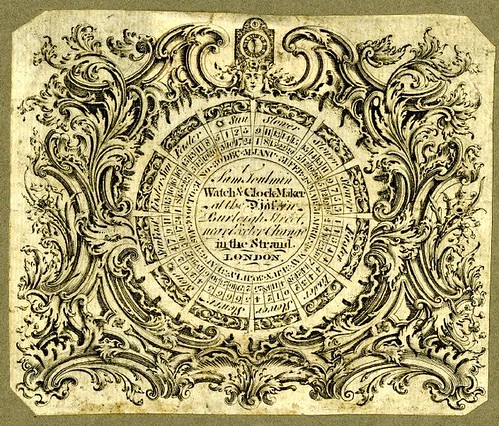



















21 comments :
Very nice.
The one you've put "what" after is a cryptogram. It says "Be (bee) watchful."
Or a rebus.
I expect you two lightning round responders to be here front and centre for the next post. Hint: brush up on your Dutch.
T R Hummer beat me to it! Be watchful.
#8 is so interesting and unexpected.
#8 is perhaps an early rendition of a smiley face. I have to admit it's my least favorite of the bunch. But all of these are fascinating.
There seems to be so much ephemera in the world. I had no idea these were collectibles. OR that they even existed. Wonderful. Thanks for sharing.
what a wonderful "piece" for a watch. I am always amazed at the fine little details of something like this for a simple "cover"- are there Any such details in today's world? thank you for this "finding" LA
Just beatiful...all the blog!
"Esoteric" is decidedly the word.
I like the rebus but surely the insect looks more like a fly than a bee? Despite the stripes on the abdomen...
Oh, I am proud (and slightly worried) about knowing what watch papers are! A very odd thing for a teenager to know, but that's me.
Fantastic. I had never heard of these before, and now I am dying to get my hands on one. Will have to keep my eyes peeled.
Although I'm not particularly into tattooing I often speculate on how great some of the stuff you post might be if incorporated or modified into a modern tattoo design. There are some great layouts and typography here, especially the Richard Whiteaves paper which would look great when tweaked a little.
Extraordinary and wonderful! Thanks so much for this posting. I have a small collection of watch papers, but I had no idea of the broad variety that existed until now. Thanks especially for the link to the British Museum site.
Fabulous, and such high quality images with every little tear discernible. I have been disturbed by the smiley-face ever since I can remember -- I thought it came upon us sometime in my 20's, from out of nowhere. Now I know it's going on 300 years old. Does anyone know if there's an earlier one?
Elatia, I have two equally compelling, although perhaps slightly contradictory, thoughts related to the smiley face. First is to resist my usual urge to go searching because an unsophisticated face drawing with a smile is bound to be ubiquitous throughout history, suggesting that the search would be very difficult to say the least.
And the concept of a smiley, or at least the type of face to which I think you refer, is always in a circle isn't it? Because these roundels for the watch-papers are purpose-cut of course, meaning that the smiley up above might just be an accidental smiley and that the 1920s are still the more likely time of its true origin, n'est-ce pas?
Oh. Oops...the smiley above does have a circle: scratch that part 2 and remove the contradiction caveat then.
Ha! The smiley face was invented by Harvey Ball in 1964. *search twice, comment once* ought to be my motto.
I was just going to say, I didn't think Elatia dated back to the 1920s. Interesting, though, that the horrible yellow smiley-face didn't make it to my neighborhood until about 1971. Then they were everywhere. I used to draw fangs on them, of course.
I have to agree with Karla - I thought the insect was a fly - something along the lines of "time flies" but I couldn't see how the "full" related.
Have bees changed that much?
Thanks again, Peacay, for a fantastic find and for sharing it with all of us!
I'm obliged to David Shields from the College of Fine Arts at the Univ. of Texas, Austin, for passing on an article on watchpapers from 1948.
'Watchpapers: A Neglected Deceit' by Roland Knaster appeared in the quarterly UK magazine, Alphabet and Image.
A snippet from that 7 page article is available online (produced in full below)
---------->quote<---------
"Watchpapers were discs that were used by Georgian and Victorian watchmakers, they were used to prevent dust from entering through the keyhole and were put between the watch and the outer case.
At first they were made from linen, but eventually white paper, pink, green, or yellow paper became the standard. Later the watchpapers were engraved and decorated with a horological motto, or verse. Some of the watchpapers have intricate borders, and some not so intricate, but they all have a border which keeps the illustrations/ mottoes trapped in a circular shape. Many of these watchpapers have the mottoes that a loved one would have engraved for special occasions.
The development of the watchpapers can be broken down into 4 stages, the first has fully decorated, but readable announcements from the early 19th century. The second, is whimsical and sometimes religious pieces, like The Lord's Prayer, which has been printed on embossed paper. The third is a lithographed example that still shows allegiance to Thorne's fat face type from the late 19th century. And the final stage is a modern example, small and practical, without being too overly decorative, like in previous generations."
<-----------------end---->
I'll just add the final para. from the article:
<--------quote--->
"Amongst mottos, as may be expected, tempus fugit, and for the uninitiated, time flies, were supreme, but it is the verse, reminiscent of so much sepulchral-verse written for children in the early nineteenth century, that brings us, unrepentant sinners, to an immediate decision to confess without delay. May I conclude with one of these immortal, or maybe mortal verses?"
Behold, O Mortal Man
How Swift thy Moments fly,
Thy Life is but a span,
Prepare, Prepare to die.
<----unquote--->
#13- where you asked "What?!", is most likely:
Bee-watch-full!
Post a Comment
Comments are all moderated so don't waste your time spamming: they will never show up.
If you include ANY links that aren't pertinent to the blog post or discussion they will be deleted and a rash will break out in your underwear.
Also: please play the ball and not the person.
Note: only a member of this blog may post a comment.